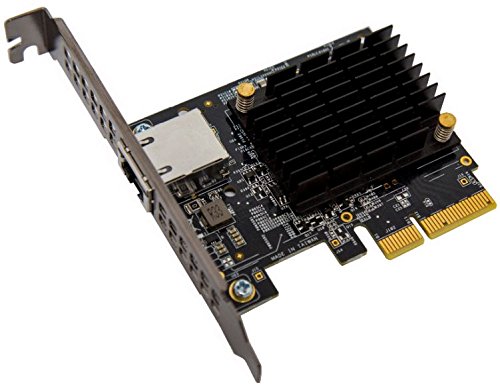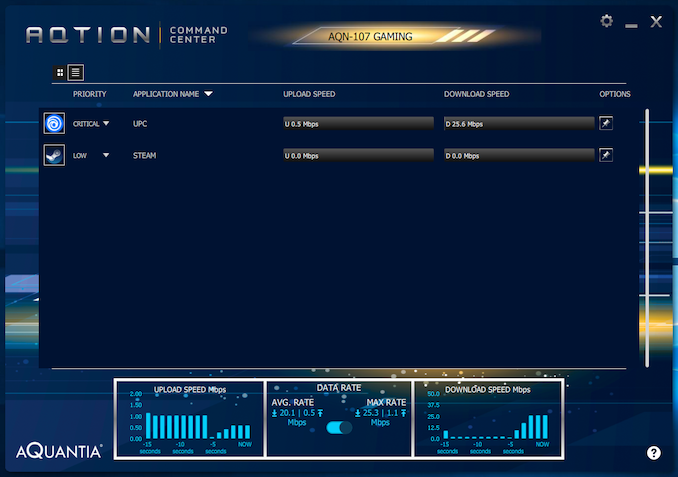Networking Priority: Aquantia Introduces Action Center and Black Friday Deal on 10G
by Ian Cutress on November 19, 2018 12:15 PM EST- Posted in
- Networking
- Aquantia
- AQC107
- AQN-107
- QoS
- Black Friday

For a number of years, there has only really been one player in the home networking priority space with software aimed at gamers. Today, that changes: since the launch of Aquantia’s multi-gigabit Ethernet cards that allow 2.5G, 5G and 10GBase-T connectivity over standard RJ-45 connections, the company has put work into its own networking priority software. The point of the software is to enable quality by prioritizing the network traffic, such that users who are simultaneously doing many things can ensure that software that requires low-latency (such as audio, or gaming) takes center stage. Aquantia’s software is called Action Center, launching in conjunction with a Black Friday deal.
Action Center
The point of network prioritization is hard to get across in text alone. The easiest way is to take the example of someone playing a ping-sensitive game, just as Counter Strike, while also punishing their connection with a heavy download simultaneously. Without any prioritization, both connections have the same priority, and the ping-sensitive game gets swamped purely on the amount of data the download requires. Ping shoots up, and the game is lost.
With prioritization, the network packets coming out of the system are tagged with a priority. Those at the top priority hop on the express lane and shoot straight out, while others are queued behind. Of course, coming the other way is different, but if the user is only downloading, then the gaming packets are still processed as they come in. If the upload is also being attacked, then the user can have the software limit the program doing the uploading, to enable bandwidth for the game packets.
It doesn’t have to be game packets – imagine trying to take a business call while Windows is downloading in the background. Or presenting over a network where it’s important that the audio discussion is prioritized over presentational video.
So if we accept that network prioritization is a good thing to have control over, even if it’s just the outbound packets from a single machine, the other question always becomes about CPU load. Aquantia is promoting that they use less CPU load than the competition as the prioritization is hardware accelerated.
The software is relatively easy to use. By default a few hundred of the most common applications are listed with set priorities, and users can adjust the priority as required. The system background processes are hidden to begin with, but users can show them if needed. The software will detect non-listed apps as well, but default them to the lowest priority. This is where the competition has a one-up in that they detect the type of connection and adjust priority accordingly.
For a step into network prioritization software, Aquantia’s Control Center is easy to understand with its layout. I’m looking forward to seeing how the software evolves.
Black Friday: Buy Two, get 25% Off
In line with the launch of the Action Center, Aquantia is implementing a Black Friday deal on its $90 10GBase-T Gamer Edition AQN-107 PCIe cards purchased through Amazon. These cards support 1G, 2.5G, 5G and 10G through RJ-45, on a PCIe x4 connection. These Gamer Edition parts include an enhanced heatsink as well as color matching for any gaming machine. Any qualifying purchase of two AQN-107 cards between 12AM Friday to Monday 11:59PM will get an extra 25% discount, with the idea that if a user buys two, it allows for point-to-point connectivity. The qualifying hardware link is below.













24 Comments
View All Comments
DanNeely - Monday, November 19, 2018 - link
Just running a direct connection from my PC to my NAS (in addition to the one via my router) isn't that exciting. The bundle I want is 2 cards and a 4 port switch or router so I can have the core of a high speed network in place as additional machines are upgraded.CaedenV - Monday, November 19, 2018 - link
For now I don't mind setting up a 2nd direct connection to my server. As long as it is a separate vlan, it should not pose much of an issue. Going from my SSDs, to my 10-bay NAS should max out ~800MB/s instead of the 100MB/s I have now... that would be amazing!romrunning - Monday, November 19, 2018 - link
It would be nice to see some copper-only 10GBe switches for lower prices. The NIC side has gotten cheaper, but the switch side is still pretty high per port. Granted, it's more helpful in the enterprise, but I know I would be smiling if I could get it at home for cheap, even if my full use of it would be limited (mainly backups for me).nagi603 - Tuesday, November 20, 2018 - link
Yeah, my problem exactly. The cheapest I ever found was still over €400 for a switch. Even Netgear's relatively new, "cheap" unmanager ones cost a bit too much (XS505M/XS508M, €400 / €525) to switch.CheapSushi - Monday, November 19, 2018 - link
Awesome! I bought an Aquantia card I believe last Black Friday also with a discount I saw on Anandtech but the 5G card. This year I'll grab two 10G cards (the black PCB, I'm a sucker for that).oRAirwolf - Monday, November 19, 2018 - link
I wish anandtech would review some network chipsets so we could make informed decisions about what to use for gaming or transferring files. I am using an integrated AQC107 on my gaming desktop to connect to my 10Gbe switch for fast transfers to a few servers, but I don't have any idea how good or bad it is compared to other network chipsets from a latency, CPU, or FPS perspective. I assume it is fine, but the fact that it is so much cheaper than the competition makes me somewhat weary of it's impact on my system performance.Ian Cutress - Monday, November 19, 2018 - link
Reviewing networking hardware is actually quite difficult. Beyond peak throughput, there's a question of power, latency, congestion/QoS, and all having the right setup to do so. Power, for example, is a painful one to crack. There have been a lot of bad networking controller reviews over the years that go beyond a simple peak throughput test. I once asked our audience and the list of requirements was very long and beyond my expertise.iwod - Tuesday, November 20, 2018 - link
Thx for answering anyway. I have always been wondering whether AQC107 in the Mac are any good. But my guess ( hopefully I am right ) is that all NBase-T are good enough, the rest is just power usage and price.Dug - Tuesday, November 20, 2018 - link
I can tell you from experience that not all base-t 10Gb nics are good enough.There is so much going on in the hardware and software, unless you are a networking guru it's very hard to configure and track down issues. And even then there can be issues that can't be solved.
Kevin G - Tuesday, November 20, 2018 - link
The catch is that most of the AQC-107 cards do not have Mac compatible firmware. macOS 10.3.3 (and only 10.3.3) has a "bug" in the ACQ-107 driver that'll update 3rd party cards with updated Mac firmware. Once that happens though, it'll work fine including AVB audio of the network capabilities. Pretty neat since macOS natively supports AVB audio output over the network. I have been leveraging this with VLC to output 7.1 audio from Blu-ray rips to a network DSP I also own.